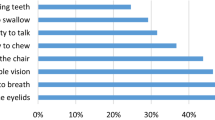Abstract
Aim of this study is to verify whether there is concordance between disease’s severity, health-related quality of life (HRQoL) and disability in patients with Myasthenia gravis (MG). 102 MG patients were clustered on the basis of HRQoL and disability scores into three groups: low disability and low HRQoL decrement (51 patients), intermediate disability and HRQoL decrement (28 patients), severe disability and high HRQoL decrement (23 patients). Cross tabulation with symmetric measures (Cramer’s V and Contingency Coefficient) was used to verify the relationships between disease severity groups, based on the Myasthenia Gravis Foundation of America (MGFA) criteria, and obtained clusters. Results confirm a significant relationship between MG severity groups, HRQoL and disability profiles. In our opinion, HRQoL and disability instruments should be employed in clinical trials to match efficacy of treatments, measured on symptoms’ reductions only, with their effects on patients’ disability and HRQoL.
Similar content being viewed by others
References
Conti-Fine BM, Milani M, Kaminski HJ (2006) Myasthenia gravis: past, present, future. J Clin Invest 116:2843–2854
Jaretzki A 3rd, Barohn RJ, Ernstoff RM, Kaminski HJ, Keesey JC, Penn AS, Sanders DB (2000) Myasthenia gravis: recommendations for clinical research standards. Task Force of the Medical Scientific Advisory Board of the Myasthenia Gravis Foundation of America. Neurology 55:16–23
Vincent A, Palace J, Hilton-Jones D (2001) Myasthenia Gravis. Lancet 357:2122–2128
Mantegazza R, Baggi F, Antozzi C, Confalonieri P, Morandi L, Bernasconi P, Andreetta F, Simoncini O, Campanella A, Beghi E, Cornelio F (2003) Myasthenia gravis (MG): epidemiological data and prognostic factors. Ann N Y Acad Sci 998:413–423
Barohn RJ, Mcintire D, Herbelin L, Wolfe GI, Nations S, Bryan W (1998) Reliability testing of the quantitative myasthenia gravis score. Ann NY Acad Sci 941:769–772
Pauda L, Evoli A, Aprile I, Caliandro P, Mazza S, Padua R, Tonali P (2001) Health-related quality of life in patients with myasthenia gravis and the relationship between patient-oriented assessment and conventional measurements. Neurol Sci 22:363–369
Paul RH, Nash J, Cohen RA, Gilchrist JM, Goldstein JM (2001) Quality of life and well-being of patients with myasthenia gravis. Muscle Nerve 24:512–516
Padua L, Evoli A, Aprile I, Caliandro P, D’Amico P, Rabini A, Tonali P (2002) Quality of life in patients with myasthenia gravis. Muscle Nerve 25:466–467
Rostedt A, Padua L, Stålberg EV (2006) Correlation between regional myasthenic weakness and mental aspects of quality of life. Eur J Neurol 13:191–193
Rostedt A, Padua L, Stalberg EV (2005) Correlation between a patient-derived functional questionnaire and abnormal neuromuscular transmission in Myasthenia Gravis patients. Clin Neurophysiol 116:2058–2064
Scott KR, Kothari MJ (2006) Self-reported pain affects quality of life in Myasthenia Gravis. J Clin Neuromusc Dis 7:110–114
Happe S, Klosch G, Zeitlhofer J (2004) Perception of dreams and subjective sleep quality in patients with myasthenia gravis. Neuropsychobiology 50:21–27
Sanders DB, Hart IK, Mantegazza R, Shukla SS, Siddiqi ZA, De Baets MH, Melms A, Nicolle MW, Solomons N, Richman DP (2008) An international, phase III, randomized trial of mycophenolate mofetil in myasthenia gravis. Neurology 71:400–406
Rostedt A, Padua L, Stalberg EV (2006) Validation of the Swedish version of the disease-specific Myasthenia Gravis Questionnaire. Neurol Sci 27:91–96
Padua L, Galassi G, Ariatti A, Aprile I, Caliandro P, Evoli A, Pazzaglia C, Tonali P (2005) Myasthenia gravis self-administered questionnaire: development of regional domains. Neurol Sci 25:331–336
Mullins LL, Carpentier MY, Paul RH, Sanders DB, Muscle Study Group (2008) Disease-specific measure of quality of life for Myasthenia Gravis. Muscle Nerve 38:947–956
Burns TM, Conaway MR, Cutter GR, Sanders DB, Muscle Study Group (2008) Less is more, or almost as much: a 15-item quality of life instrument for myasthenia gravis. Muscle Nerve 38:957–963
Leonardi M, Bickenbach J, Ustun TB, Kostanjsek N, Chatterji S, MHADIE Consortium (2006) The definition of disability: what is in a name? Lancet 368:1219–1221
World Health Organisation (2001) The international classification of functioning, disability and health-ICF. WHO, Geneva
Apolone G, Mosconi P (1998) The Italian SF-36 health survey: translation, validation and norming. J Clin Epidemiol 51:1025–1036
Ustun TB (1999) WHO-DAS II Field Trials Report 1998. WHO, Geneva
Bedlack RS, Simel DL, Bosworth H, Samsa B, Tucker-Lipscomb B, Sanders DB (2005) Quantitative myasthenia gravis score: assessment of responsiveness and longitudinal validity. Neurology 64:1968–1970
Mantegazza R, Antozzi C, Peluchetti D, Sghirlanzoni A, Cornelio F (1988) Azathioprine as a single drug or in combination with steroids in the treatment of myasthenia gravis. J Neurol 255:449–453
Sharshar T, Chevret S, Mazighi M, Chillet P, Huberfeld G, Berreotta C, Houfani M, Gajdos P (2000) Validity and reliability of two muscle strength scores commonly used as endpoints in assessing treatment of myasthenia gravis. J Neurol 247:286–290
Wolfe GI, Herbelin LR, Nations SP, Foster B, Bryan WW, Barohn RJ (1999) Myasthenia gravis activities of daily living profile. Neurology 52:1487–1489
Vanderveldea L, Van den Bergh PYK, Goemans N, Thonnard JL (2007) ACTIVLIM: a Rash-built measure of activity limitations in children and adults with neuromuscular disorders. Neuromuscul Disord 17:459–469
Conflict of interest statement
The authors declare no conflict of interest.
Author information
Authors and Affiliations
Corresponding author
Rights and permissions
About this article
Cite this article
Raggi, A., Leonardi, M., Antozzi, C. et al. Concordance between severity of disease, disability and health-related quality of life in Myasthenia gravis. Neurol Sci 31, 41–45 (2010). https://doi.org/10.1007/s10072-009-0167-y
Received:
Accepted:
Published:
Issue Date:
DOI: https://doi.org/10.1007/s10072-009-0167-y




